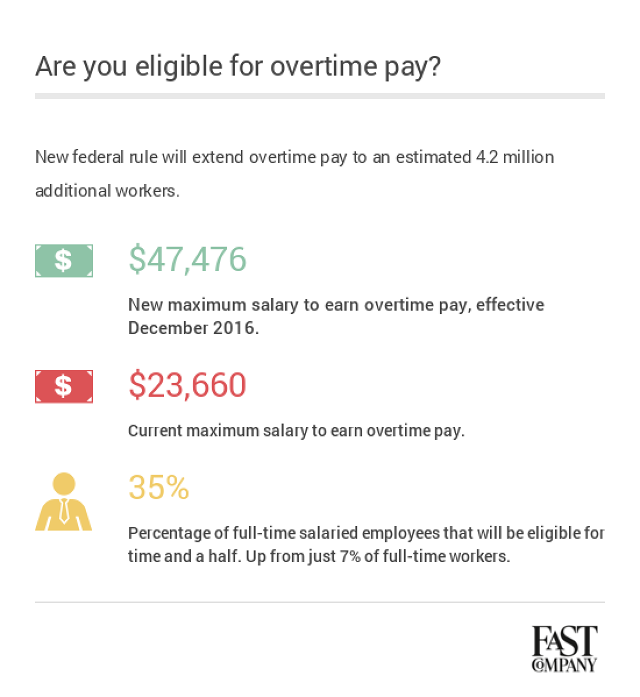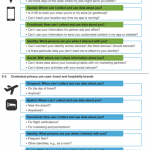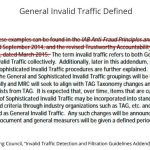Here’s How The New Overtime Law Will Affect You
A new overtime rule is about to greatly impact the American middle class.
The Department of Labor (DOL) has announced an updated regulation that increases the salary threshold for paid overtime from less than $455 per week to $913 per week. Before, salaried workers were only entitled to paid overtime if they made less than an annual salary of $23,660. Today, employees who earn yearly salaries of $47,476 or less will be entitled to paid overtime if they work more than 40 hours a week.
What The New Rule Means
According to the DOL, these new rules will extend new overtime protections to 4.2 million workers in the United States. The Economic Policy Institute (EPI) has a much larger statistic, saying that these changes will impact 12.5 million Americans. This difference is a result of the DOL not including employees who were misclassified by their employers in its count.
This is because earlier rules exempt “high-level” workers from overtime, and based this on what was called a “duty test.” Many employers seized on this opportunity to change job descriptions to make it seem as if lower-level employees were performing more expert tasks, thus exempting them from overtime. This new rule makes things much clearer: If a worker makes less than $47,476, they are eligible for extra compensation if they work more than 40 hours a week, regardless of their job title or description. The EPI estimates that there are more than 8 million people who will now be more easily classified as eligible for the extra compensation, since they were considered exempt before due to their job descriptions.
Employers have a variety of ways to comply: They can raise these workers’ salaries to make them exempt from the overtime threshold, pay the mandated time-and-a-half overtime for those who do work more, or simply make sure employees aren’t working overtime.
These new rules will give workers in numerous demographics a significant pay boost. According to the DOL’s numbers, 2.3 million women will be eligible for these new protections, compared to 1.9 million men. Additionally, a little less than 2 million workers who have not earned college degrees will also be affected. Non-white workers too will be impacted. For example, 28% of both Hispanic and black salaried employees who were previously exempt from paid overtime will now be eligible.
What The Business Community Thinks
The change has not been well received well by some business communities. According to the Washington Post, many small businesses and other employers have said that they will be forced to switch some employees from salaried to hourly in order to comply with the changes. The National Retail Federation, in fact, released a post that deemed the rule a “career killer.”

Unlike other labor laws that don’t include small businesses, this change isn’t dependent on company size. There are, however, some professions—including teachers and contract lawyers—that have different regulations regarding their compensation.
Labor and union groups, however, are rejoicing. “Restoring overtime is the single most significant step the Administration can take to boost wages for working people,” writes the U.S. union federation the AFL-CIO in a blog post. The union adds that these new rules will also likely create new jobs. “To get around paying time-and-a-half, many employers will choose to hire new employees—or allocate more hours to their part-time workers—and pay them straight time.” So even if the naysayers do what they warn, it could end up having a positive impact on U.S. employment.
At a press conference held Wednesday, union representatives, nonprofits, advocacy organizations, small business owners, and people impacted by the change came together to praise the new regulation. They also tried to demystify claims that this could hurt the economy. Anne Babcock-Stiner of the nonprofit PathStone explained that while some of her organization’s employees will be reclassified, it ultimately makes things easier since it’s a cut and dry threshold. Christine Owens of the National Employment Law Project added to this, saying that under the new rules, “Employers have a lot of flexibility.”
How This Happened
This has been one of President Obama’s biggest agendas for the last few years. He first announced his plans to change the threshold in 2014, but bolstering the middle class has long been part of Obama’s agenda. The overtime rule has not been changed since 2004, meaning employee wages fell behind as the economy changed and the price of living rose. The final rule takes this into account, too, as the threshold will be automatically updated every three years, “based on wage growth over time.”
The Obama Administration has also been working for other employee safeguards. For example, Vice President Joe Biden has been an ardent supporter of raising the national minimum wage. Last year, he joined Andrew Cuomo to help push New York to increase its minimum wage to $15 per hour. Though no national legislation has made it through just yet, the fight for a much higher minimum wage has been gaining traction over the last few years, thanks to these efforts.
As Obama’s term comes to an end, he’s beginning to make some headway. “The middle class is getting clobbered, although I think we’re making some progress here,” said Biden at a press conference, according to the Washington Post.
The new rules go into effect December 1, 2016, so businesses have a little bit of time to figure out how to adapt. After that, it seems many Americans will then begin to see better and fairer compensation.
Now you’ve got overtime, it’s time to work on your work/life balance
Fast Company , Read Full Story
(34)














